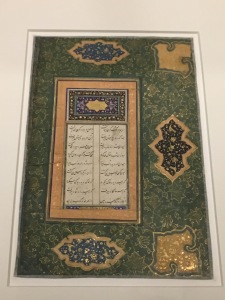I apologize, readers. It’s been a long time since I posted anything in Errant. Too long. I have no excuse except I’ve been busy.
“Haven’t we all,” you reply.
Touché, touché…
Even if I have no excuse, it’s true that archaeologists do a lot of work in the off-season. The stretches of time between our intensive fieldwork and lab work sessions is when we read articles, write articles, become familiar with the latest techniques, and build new skills. So what did I do that took so much time I couldn’t write?
Well, I learned French. Not enough to spontaneously compose the complete works of Zola (or even read them), but enough to earn a C1 rating on the Test de connaissance du français. Through a combination of the free online resource Duolingo, listening to the Journal en français facile, watching France 24 on YouTube, reading several novels, and watching hours of sitcoms (subtitles off), I immersed myself in French language and grammar for two intense months. Then I traveled to Chicago – the nearest city where the TCF is given – and took my chances. The hard work paid off.
My desire to learn French is mostly personal: the research team I work with at the Museum national d’Histoire naturelle speaks excellent English. Even so, I feel it’s both respectful and useful to speak the language of the country where you’re working, wherever that happens to be. Everything from buying groceries to working with local governments goes more smoothly when you can communicate in people’s preferred language, and the show of good faith goes a long way, especially if you work in an area where there’s a reputation for colonialism left over from archaeology’s Bad Old Days.
But French wasn’t my only project since November. I also finished editing a book. Water and Power in Past Societies is the result of an international conference of invited scholars that I organized when I was the postdoctoral fellow at the Institute for European and Mediterranean Archaeology. Editing the volume that resulted from that conference has been a major part of my scholarly life ever since, and this year it finally drew to a close. Immediately after my trip to Chicago, I turned my attention to the line edits and indexing, and the book appeared in print in April. I couldn’t be prouder of the result, or more grateful for the opportunity to work with the inspiring scholars whose research is featured.
Still, editing a book didn’t seem like quite enough, so I wrote reviews of three others. Professional book reviews are an essential part of most peer-reviewed journals, and they help colleagues decide whether particular books will be useful for their research or teaching. Writing reviews is also a good way to get a free copy of a book you want to read, but don’t be fooled – when I divided out the price of the books I reviewed by the number of hours I spent working on each review, my average pay came to about $4 an hour. Two of the reviews are still forthcoming, but you can check out one of them here if you’re curious.
Not everything I worked on since November was a new project. One was an old project that landed back on my desk rather unexpectedly. In 2014, I wrote an article on Nuragic archaeology for the Encyclopedia of Global Archaeology, and right around the time I left Paris, I was informed it was time for me to update it. A number of new works had come out in my field since 2014, so updating the article meant catching up on a lot of scholarship I had been neglecting while my attention was focused on Water and Power.
And last but not least, when all the rest was done, I managed to write a 20-page report on the zooarchaeological research I did at Tel Akko in Israel last summer. Working in a new area of the Mediterranean was extremely challenging, but the results were worth the effort. My contribution is only a small part of this ongoing research project, of course – I can’t wait to see what new excavation seasons add to our knowledge of animal economies and environments at this fascinating site.
So that’s pretty much what I did. Of course, all these projects were in addition to my work-for-money jobs, which included teaching archaeology and anthropology at Miami University and working as an Experience Programs Teacher at COSI, Columbus’s wonderfully engaging hands-on science museum. I’m pleased to say that, as the summer draws to a close, I’m looking forward to continuing as a Visiting Assistant Professor in the Miami University Classics Department and volunteering a few times a month at COSI.
I’m also looking at clean slate with no outstanding projects or professional obligations. I wonder what I’ll work on next…




